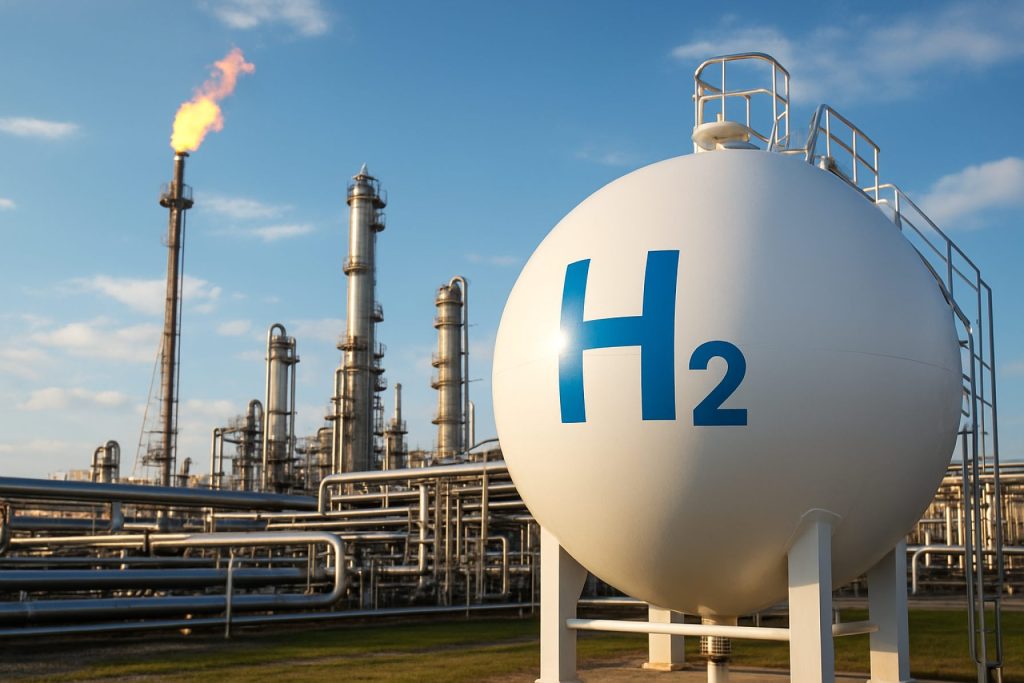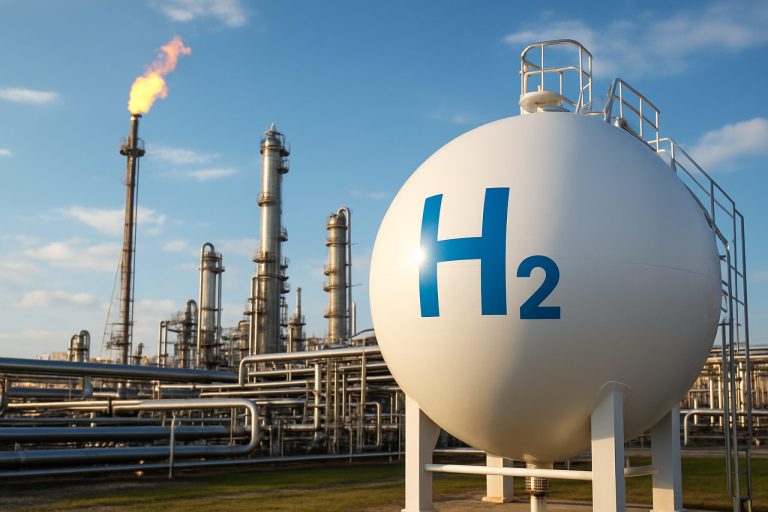
- The U.S. Department of Energy now allows blue hydrogen producers to use supply chain-specific methane data in lifecycle emission calculations.
- This policy change can help blue hydrogen projects qualify more easily for valuable federal tax credits by accurately reflecting their emissions reductions.
- Blue hydrogen, made from natural gas and carbon capture, has faced criticism due to methane leaks—a greenhouse gas significantly stronger than CO2.
- The move rewards producers using advanced methane leak detection and carbon-neutral technologies, encouraging innovation and job growth in American clean energy.
- This shift highlights Washington’s commitment to precise, science-based clean hydrogen policy, supporting ambitious climate goals and infrastructure investment.
A breeze of change stirs across America’s energy landscape as the U.S. Department of Energy shatters old barriers in the race for a hydrogen-powered future. In a remarkable shift, federal officials now allow blue hydrogen producers to enter precise, supply chain-specific methane figures into official lifecycle emission calculations—a move promising to rewrite who gets access to lucrative federal tax credits.
Blue hydrogen, known for leveraging natural gas and carbon capture technology, has faced relentless scrutiny. Critics have often pointed to pervasive methane leaks—methane being far more potent than CO2 in trapping heat within Earth’s atmosphere—as a main obstacle to its clean energy credentials. Previous rigid government models hobbled producers, forcing them into broad emission estimates that put federal incentives just out of reach.
That changes now. DOE’s new policy lets companies showcase their on-the-ground methane control efforts by reporting detailed, site-specific data. For producers already investing in advanced leak detection and carbon-neutral practices, the landscape just brightened—the incentives that prop up the industry and drive jobs in American clean tech suddenly look more attainable.
The decision signals a mature, pragmatic approach from Washington, balancing clean energy ambition with scientific accuracy. As new infrastructure and jobs sprout from this hydrogen surge, the ripple effects could be profound. Blue hydrogen’s fate no longer hangs on one-size-fits-all assumptions; the innovators can now prove—down to the pipeline—just how low their emissions run.
For those watching the energy evolution unfold, this isn’t just a technical tweak. It underscores a fundamental message: Aggressive climate targets hinge not only on technology, but on policy crafted with precision and grounded in credible, real-world data.
The takeaway? As America’s hydrogen dawn accelerates, it pays to track both the molecules—and the math—that will shape our planetary future.
Hidden Forces Unleashed: What DOE’s New Blue Hydrogen Policy Means for the Future of Clean Energy, Jobs, and Your Wallet
Deeper Dive: The Game-Changing Blue Hydrogen Policy and Its Wider Impact
The U.S. Department of Energy (DOE) recently rocked the energy industry by updating how blue hydrogen producers can measure and report methane emissions. This nuanced policy shift goes beyond the headlines, raising new questions about America’s clean energy future, the integrity of climate policy, and the competitive landscape of hydrogen production. Here, we unpack additional facts, answer burning questions, and deliver actionable insights for industry insiders, investors, and eco-conscious citizens alike.
—
Blue Hydrogen: Fast Facts and Fresh Context
– What is Blue Hydrogen?
Blue hydrogen is produced from natural gas, with carbon emissions captured and stored or reused. It sits between “grey” hydrogen (from fossil fuels without carbon capture) and “green” hydrogen (from renewable sources like wind or solar).
– Methane’s Impact:
Methane has over 80 times the warming power of CO₂ over a 20-year period ([U.S. EPA](https://www.epa.gov)), so leaks during natural gas extraction and transport can heavily impact blue hydrogen’s climate credentials.
– Previous Policy Flaw:
Until now, the federal government required companies to use industry-wide, often outdated methane leakage averages. This consistently excluded the most advanced, responsible blue hydrogen projects from critical tax credits and incentives.
—
Industry Impact: Who Stands to Gain or Lose?
– Unlocking Investment:
With accurate, site-specific data, companies at the cutting edge of methane detection and control technology can now qualify for billions in federal tax credits and grants. This could drive increased investment into American natural gas infrastructure, leak detection, and carbon capture innovation.
– Job and Regional Impact:
The move could create tens of thousands of jobs, particularly in traditional energy hubs pivoting to clean tech, such as Texas and Louisiana. According to the DOE, hydrogen could create up to 700,000 direct and indirect U.S. jobs by 2030.
– Boost for Suppliers:
Equipment manufacturers (e.g., for advanced methane sensors or carbon capture tech) now find a larger customer base among blue hydrogen producers striving for cleaner operations.
—
Burning Questions Answered
1. Will Blue Hydrogen Now Rival Green Hydrogen?
No—at least, not entirely. The change improves blue hydrogen’s standing but it doesn’t erase fundamental differences:
– Green hydrogen is still the gold standard for emissions, leveraging renewables with zero direct fossil-fuel use.
– Blue hydrogen will remain under scrutiny due to upstream emissions and long-term storage concerns for captured CO₂ ([IEA](https://www.iea.org)).
2. How Can Producers Accurately Measure Methane?
Leading companies are deploying:
– Aerial and satellite-based methane sensors
– Continuous onsite monitoring
– Regular third-party audits
These approaches are now rewarded in federal calculations, incentivizing accuracy and transparency.
3. Are There New Risks or Criticisms?
– Controversy: Environmental groups argue this could “greenwash” fossil-fuel hydrogen if not paired with robust, transparent oversight.
– Limitation: Small producers may face higher costs meeting new monitoring/reporting standards.
—
Features, Specs, and Economic Realities
Features of Advanced Blue Hydrogen Plants
– CCUS Integration: Onsite carbon capture rates over 90%
– Methane Leak Detection: Real-time or quarterly reporting
– Sustainable Siting: Proximity to CO₂ storage or utilization partners
– Digital Monitoring: Blockchain or other digital ledgers for traceability
Market Forecasts & Industry Trends
– Global Blue Hydrogen Market Size: Forecast to grow to $48B by 2030 (BloombergNEF)
– U.S. Leadership: America expected to be a top-three global producer due to tax incentives and natural gas reserves.
—
How-To: What Steps Should Companies Take?
1. Upgrade Leak Detection:
Invest in best-in-class methane sensors and software to quantify leaks accurately.
2. Partner for Independent Audits:
Third-party validation boosts credibility and ensures compliance.
3. Track and Report Data Digitally:
Adopt digital platforms for transparent, real-time emissions tracking.
4. Team Up with Local Stakeholders:
Align with community and environmental groups for shared oversight.
—
Pros, Cons, and Critical Considerations
Pros
– Rewards genuine emission reductions
– Spurs tech innovation and clean energy jobs
– Increases U.S. competitiveness in global hydrogen markets
Cons
– Risk of data manipulation or selective reporting
– Could delay transition from blue to green hydrogen if not managed cautiously
– Potential loopholes if standards or audits are inconsistent
—
Security, Sustainability, and Policy Integrity
– Security: Better monitoring reduces leak-related safety risks across pipelines and storage.
– Sustainability: Higher incentives spur long-term emission reductions but true climate neutrality still demands transition to green hydrogen.
– Policy Watch: Regular review and transparent publication of emission data will be critical to prevent abuse.
—
Actionable Quick Tips
– For Energy Executives: Start methane monitoring upgrades now to fast-track access to credits.
– For Policymakers: Push for nationwide transparency in emissions reporting.
– For Investors: Monitor blue hydrogen companies’ reporting practices—those with the best transparency and tech will likely outpace competitors.
– For Consumers: Advocate for greener hydrogen choices and support policies holding producers accountable.
—
The Bottom Line
This new DOE policy isn’t just a technical revision—it’s a watershed moment that will shape America’s clean energy economy for the next decade. As the hydrogen landscape rapidly evolves, staying informed and engaged ensures all stakeholders—from producers to ordinary citizens—can play a role in America’s energy transformation.
For more on U.S. energy policy and hydrogen innovation, visit the official Department of Energy.
Stay tuned, stay informed, and demand both cleaner technology and clearer math as the hydrogen future takes shape.



